Mercedes-Benz SL-Class 2006 COMAND Manual

230
COMAND Operator’s Manual
Order-No. 6515 6716 13 Part-No. 230 584 86 83 US Edition B 2005
COMAND Operator’s Manual

We reserve the right to modify the technical details
of the COMAND system as given in the data and illustrations
of this Operator’s Manual.
Press time: 12/08/2004
Reprinting, translation and copying, even of excerpts, is not permitted without prior authorization in writing.
Title illustration no. P00.01-2917-31

230_Innentitel_vorn_US_B.fm Seite 1 Mittwoch, 8. Dezember 2004 3:22 15
Welcome to COMAND!
Please make yourself familiar with your COMAND control unit and read the instructions in this manual before operating the COMAND system. This will help you derive a greater benefit from the system. Please also follow the instructions and warnings contained in this manual. Ignoring them could result in damage to the vehicle or personal injury to you or others.
The asterisk* identifies optional equipment. Depending on model, version and configuration, your COMAND system equipment may differ. Therefore, you may find explanations for optional equipment not installed in your vehicle. If you have any questions about the operation of any equipment, your authorized MercedesBenz Center will be glad to demonstrate the proper procedures.
We continuously strive to improve our product and ask for your understanding that we reserve the right to make changes in design and equipment. Therefore, information, illustrations and descriptions in this manual might differ from the equipment installed in your vehicle. As such, the information, illustrations and descriptions contained in this manual may not be reasonably relied upon in making any claims with respect to the actual performance of the product.
These operating instructions form an integral part of the vehicle and should therefore always be kept inside the vehicle and passed on to the new owner if the vehicle is sold.
We extend our best wishes for many miles of safe, pleasurable driving.
Mercedes-Benz USA, LLC
A DaimlerChrysler Company

230_Innentitel_vorn_US_B.fm Seite 2 Mittwoch, 8. Dezember 2004 3:22 15
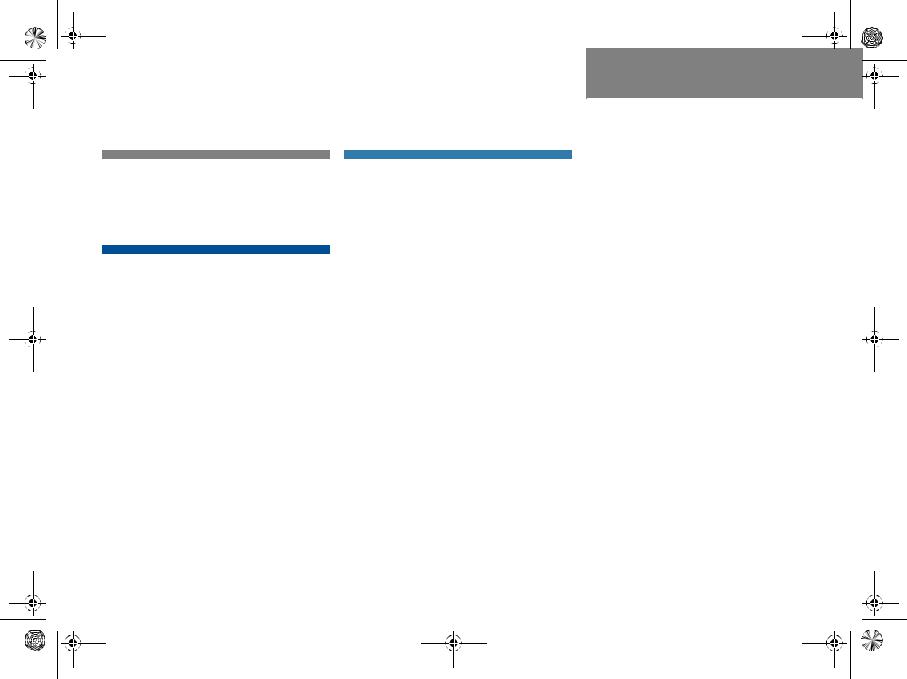
230_US_Edition_B_2005IVZ.fm Seite 3 Mittwoch, 8. Dezember 2004 3:26 15
Contents
Introduction . . . . . . . . . . . . . . . . . . . . . 7 Where to find it . . . . . . . . . . . . . . . . . . . 7 Symbols . . . . . . . . . . . . . . . . . . . . . . . . . 8 Operating safety. . . . . . . . . . . . . . . . . . . 9
At a glance . . . . . . . . . . . . . . . . . . . . . 11 Radio operating elements . . . . . . . . . . 12 CD operating elements . . . . . . . . . . . . 14 Satellite radio* operating elements . . . 16 Telephone* operating elements . . . . . . 18 Navigation operating elements . . . . . . 20 Service operating elements . . . . . . . . . 22 Menu system . . . . . . . . . . . . . . . . . . . . 24 Quick reference COMAND . . . . . . . . . . 27
Switching the COMAND
control unit on and off . . . . . . . . . . 27 Volume . . . . . . . . . . . . . . . . . . . . . . 27 Balance . . . . . . . . . . . . . . . . . . . . . . 29 Bass and Treble . . . . . . . . . . . . . . . 30 Sound functions* . . . . . . . . . . . . . . 31
Audio . . . . . . . . . . . . . . . . . . . . . . . . . . 33 Audio menu . . . . . . . . . . . . . . . . . . . . . 34 Opening the Audio menu . . . . . . . . 34 Selecting an audio source . . . . . . . 34 Muting . . . . . . . . . . . . . . . . . . . . . . 34 Radio operation . . . . . . . . . . . . . . . . . . 35 Switching the radio operation on . . 35 Changing the Radio band . . . . . . . . 35 Selecting a station . . . . . . . . . . . . . 37 Memory functions. . . . . . . . . . . . . . 40 CD operation . . . . . . . . . . . . . . . . . . . . 44
General Information
on CD operation . . . . . . . . . . . . . . . 44 Tips on caring for your CDs . . . . . . 45 Switching to CD operation . . . . . . . 46 Loading CDs . . . . . . . . . . . . . . . . . . 46 Switching on . . . . . . . . . . . . . . . . . . 48 Selecting a CD (CD changer* only). 49 Track select . . . . . . . . . . . . . . . . . . 50 Fast forward/reverse . . . . . . . . . . . 52 Muting . . . . . . . . . . . . . . . . . . . . . . 53 Playback mode . . . . . . . . . . . . . . . . 53
MP3-CD operation . . . . . . . . . . . . . . . . 55 General Information . . . . . . . . . . . . 55 Tips on caring for your MP3-CDs . . 56 Switching to MP3-CD operation . . . 56 MP3-CD main menu . . . . . . . . . . . . 57 Selecting a folder . . . . . . . . . . . . . . 58 Selecting a track . . . . . . . . . . . . . . . 58 Playback mode . . . . . . . . . . . . . . . . 60 MP3 options . . . . . . . . . . . . . . . . . . 61
DVD operation . . . . . . . . . . . . . . . . . . . 63 General information
on DVD operation . . . . . . . . . . . . . . 63 DVD playback requirements . . . . . . 64 Switching to DVD operation . . . . . . 64 Loading a DVD . . . . . . . . . . . . . . . . 65 Ejecting a DVD . . . . . . . . . . . . . . . . 66 Soft key display and status bar. . . . 67 Soft key functions . . . . . . . . . . . . . . 68 DVD menu. . . . . . . . . . . . . . . . . . . . 70 Settings menu. . . . . . . . . . . . . . . . . 71 Adjusting brightness, contrast
and color. . . . . . . . . . . . . . . . . . . . . 74 Selecting a movie . . . . . . . . . . . . . . 74 Selecting a scene/chapter . . . . . . . 75 Fast forward/reverse . . . . . . . . . . . 75

230_US_Edition_B_2005IVZ.fm Seite 4 Mittwoch, 8. Dezember 2004 3:26 15
Contents
Satellite radio* . . . . . . . . . . . . . . . . . . 77 Important notes . . . . . . . . . . . . . . . . . . 78 Subscribing to satellite radio . . . . . 79 Satellite radio operation . . . . . . . . . . . . 80 Switching on . . . . . . . . . . . . . . . . . . 80 Changing the program category . . . 81 Selecting a station . . . . . . . . . . . . . 81 Memory functions . . . . . . . . . . . . . . 83 Displaying information . . . . . . . . . . 84 Displaying service information . . . . 85 Sound settings . . . . . . . . . . . . . . . . 85
Telephone* . . . . . . . . . . . . . . . . . . . . . 87 Important notes . . . . . . . . . . . . . . . . . . 88 Telephone operation. . . . . . . . . . . . . . . 92 Switching telephone operation on . 92 Switching telephone operation off . 92 Emergency call “911” . . . . . . . . . . . 93 Entering codes . . . . . . . . . . . . . . . . 95 Switching to telephone operation . 96
Incoming call. . . . . . . . . . . . . . . . . . 97 Outgoing calls . . . . . . . . . . . . . . . . . 98 Active call . . . . . . . . . . . . . . . . . . . 102 Phone book . . . . . . . . . . . . . . . . . . 104 Saving phone numbers . . . . . . . . . 109
Navigation. . . . . . . . . . . . . . . . . . . . . 113 Important notes . . . . . . . . . . . . . . . . . 114 Navigation DVD. . . . . . . . . . . . . . . 115
Route guidance after the vehicle
has been transported . . . . . . . . . . 116 Trip interruption during
route guidance . . . . . . . . . . . . . . . 117 Navigation main menu . . . . . . . . . . . . 118
Activating the Navigation
main menu . . . . . . . . . . . . . . . . . . 118 Setting the route mode . . . . . . . . . 120 Audio settings for the navigation announcements . . . . . . . . . . . . . . 121 Saving current position . . . . . . . . . 122
Destination input . . . . . . . . . . . . . . . . 124 Activating the Destination Entry
menu . . . . . . . . . . . . . . . . . . . . . . 124 Selecting home address . . . . . . . . 138 Route guidance. . . . . . . . . . . . . . . . . . 139 Starting route guidance . . . . . . . . 139 Route calculation . . . . . . . . . . . . . 139 Recalculating an existing route . . . 139 Voice instructions . . . . . . . . . . . . . 139 Navigation displays . . . . . . . . . . . . 140 Arriving at destination . . . . . . . . . . 142 Cancelling route guidance . . . . . . 143 During route guidance . . . . . . . . . . . . 144 Displaying the soft keys . . . . . . . . 144 Info menu . . . . . . . . . . . . . . . . . . . 144 Via function (soft key via) . . . . . . . 146 Selecting a detour . . . . . . . . . . . . . 147 Stopover function . . . . . . . . . . . . . 149 Saving the current location . . . . . . 151 Defining route guidance displays . 151
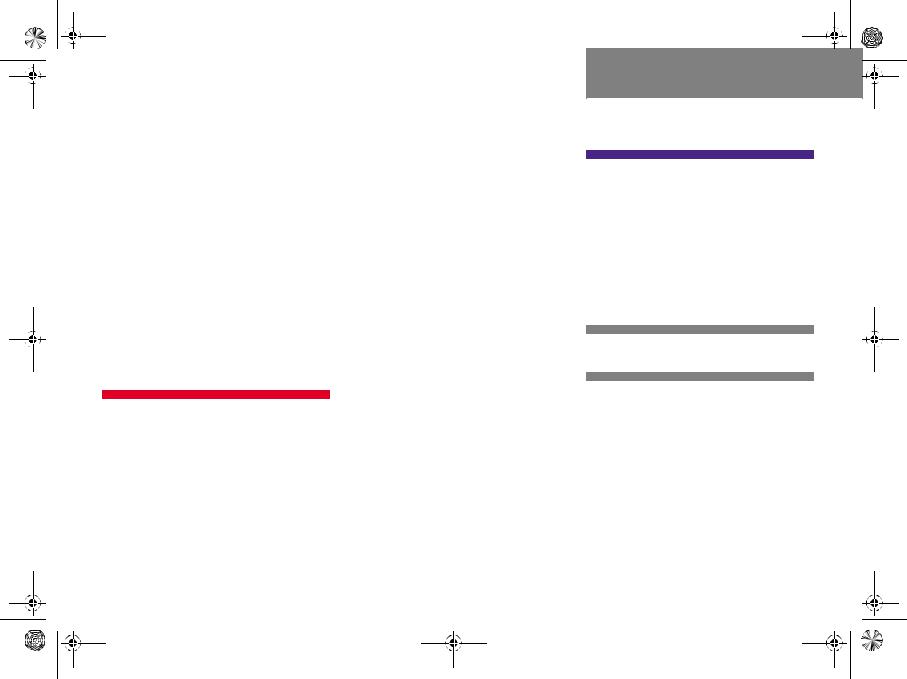
230_US_Edition_B_2005IVZ.fm Seite 5 Mittwoch, 8. Dezember 2004 3:26 15
Contents
Last destinations and destination
memory . . . . . . . . . . . . . . . . . . . . . . . 155 Last destinations memory . . . . . . 155 Destination memory . . . . . . . . . . . 156 POIs (Points of Interest) . . . . . . . . . . . 160 Entering POIs . . . . . . . . . . . . . . . . 160
Selecting a POI around
your current location . . . . . . . . . . 161 Selecting a POI around another location . . . . . . . . . . . . . . . . . . . . 162 Selecting a POI around a global destination . . . . . . . . . . . . . . . . . . 163 Selecting a POI on the map . . . . . 164
Software Updates . . . . . . . . . . . . . . . 166
Service . . . . . . . . . . . . . . . . . . . . . . . 167 Service main menu. . . . . . . . . . . . . . . 168 Activating the Service main menu 168 SMS (Mail) . . . . . . . . . . . . . . . . . . . . . 169 SMS Inbox . . . . . . . . . . . . . . . . . . 169 Reading SMS message received. . 171 Saving a sender phone number . . 172 Deleting a SMS message* . . . . . . 175
Address book . . . . . . . . . . . . . . . . . . . 176 Activating the Address book
menu . . . . . . . . . . . . . . . . . . . . . . 176 Entries in the address book . . . . . 176 Selecting an entry. . . . . . . . . . . . . 177 Details on an address book entry . 178 Details on a mobile phone internal memory entry . . . . . . . . . . . . . . . . 182 New address book entry. . . . . . . . 185 Deleting an address book entry . . 186 Using an address book entry
in other system modes . . . . . . . . . 187 Tele Aid* . . . . . . . . . . . . . . . . . . . . . . 189 General . . . . . . . . . . . . . . . . . . . . . 189 Emergency call . . . . . . . . . . . . . . . 189 Roadside Assistance. . . . . . . . . . . 190 Information call. . . . . . . . . . . . . . . 191
Remote Door Unlock and
Stolen Vehicle Recovery . . . . . . . . 192 Entering data . . . . . . . . . . . . . . . . . . . 193 Input via selection menu. . . . . . . . 193 Input via 12-button keypad. . . . . . 195
System settings . . . . . . . . . . . . . . . . 197 System settings . . . . . . . . . . . . . . . . . 198 Setting the date/time . . . . . . . . . 198
Switching verification and
notification tones on and off. . . . . 201 Making display settings . . . . . . . . 201 Voice control system* . . . . . . . . . . . . 203 Voice control system* functions . 203 Reset function . . . . . . . . . . . . . . . . . . 204
Glossary . . . . . . . . . . . . . . . . . . . . . . 205
Index . . . . . . . . . . . . . . . . . . . . . . . . . 209
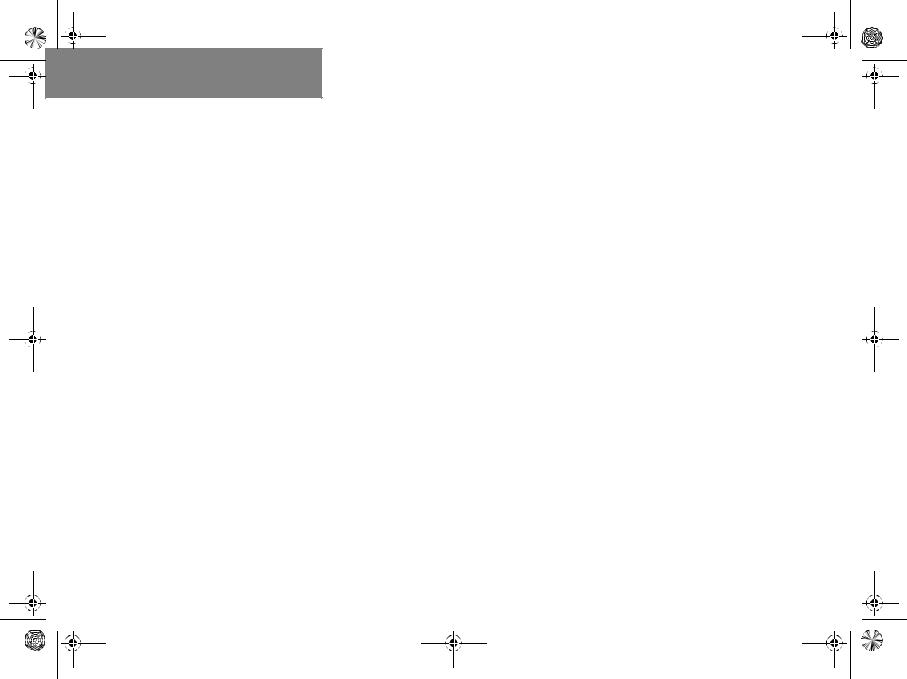
230_US_Edition_B_2005IVZ.fm Seite 6 Mittwoch, 8. Dezember 2004 3:26 15
Contents

230_Einleitung_US_B.fm Seite 7 Mittwoch, 8. Dezember 2004 3:27 15
Where to find it
This Operator’s Manual is designed to provide support information for you, the COMAND operator. Each chapter has its own guide color to provide fast access to information.
At a glance
Here you will find an overview of
all COMAND control elements and system components. If you are operating COMAND for the first time or if you have rented or borrowed the vehicle, this is the chapter you should read first.
Audio
Here you will find all the information on how to use the radio, CD player (CD, MP3-CD), CD changer* and DVD drive.
Introduction
Where to find it
Satellite radio*
This chapter provides information on how to select a station and a program category.
Telephone*
Here you can learn in detail about the many functions of the telephone, how to initiate an emergency call and use the phone book.
Navigation
This chapter provides detailed information on the following topics:
Destination input
Route guidance including detour
Last destinations and destination memory
POIs
Service
Here you will find all the information about:
SMS
Address book
Tele Aid*
System settings
This chapter provides information on how to adjust COMAND system settings.
Directories
The glossary explains the most important technical terms.
The table of contents and index directory will help you quickly locate the information you need.
7
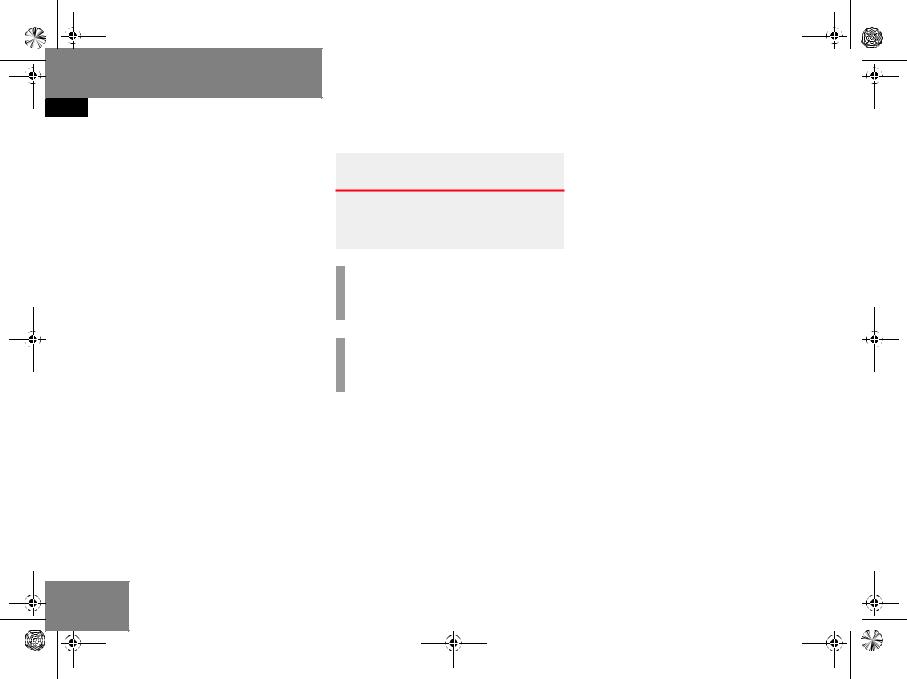
230_Einleitung_US_B.fm Seite 8 Mittwoch, 8. Dezember 2004 3:27 15
Introduction
Symbols
Symbols
You will find the following symbols in these operating instructions:
*The asterisk identifies optional equipment. Since not all models have the same standard equipment, your COMAND system equipment may deviate from some descriptions and illustrations.
Warning |
G |
Warning notices draw your attention to hazards that may endanger your health or life, or the health or life of others.
!
Highlights hazards that may result in damage to your COMAND.
i
Helpful hints or further information you may find useful.
This symbol points to instructions for you to follow.
A number of these symbols appearing in succession indicates a multiple-step procedure.
|
The continuation symbol |
|
marks an interrupted proce- |
|
dure which will be continued |
|
on the next page. |
( page 9) This symbol tells you where
|
to look for further infor- |
|
mation on this subject. |
-> |
This symbol is used in the |
|
glossary. It indicates that |
|
the term immediately follo- |
|
wing the symbol is also exp- |
|
lained in the glossary. |
Display |
Messages, menu items or |
|
soft key names appearing in |
|
the COMAND color display |
|
are printed in the type |
|
shown here. |
8

230_Einleitung_US_B.fm Seite 9 Mittwoch, 8. Dezember 2004 3:27 15
Operating safety
Warning |
G |
Any alterations made to electronic components and the software can cause malfunctions.
The radio, amplifier, CD changer*, satellite radio*, telephone*, navigation module and voice control system* are interconnected.
When one of the components is not operational or has not been removed/replaced properly, the function of other components may be impaired.
This condition might seriously impair the operating safety of your vehicle.
We recommend that you have any service work on electronic components carried out only by qualified personnel.
Warning |
G |
In order to avoid distraction which could lead to an accident, the driver should enter system settings with the vehicle at a standstill and operate the system only when road and traffic conditions permit.
Bear in mind that at a speed of just
30 mp/h (approximately 50 km/h), your car is covering a distance of 44 feet (approximately 14 m) every second.
COMAND supplies you with information to help you select your route more easily and guide you conveniently and safely to your destination. For safety reasons, we encourage the driver to stop the vehicle in a safe place before answering or placing a call, or consulting the COMAND screen to read navigational maps, instructions, or downloaded information.
Introduction
Operating safety
While the navigation system provides directional assistance, the driver must remain focused on safe driving behavior, including attention to traffic and street signs, and should utilize the system’s audio cues while driving.
The navigation system does not supply any information on stop signs, yield signs, traffic regulations or traffic safety rules. This always remains your personal responsibility when you drive. DVD maps do not cover all areas nor all routes within an area.
9
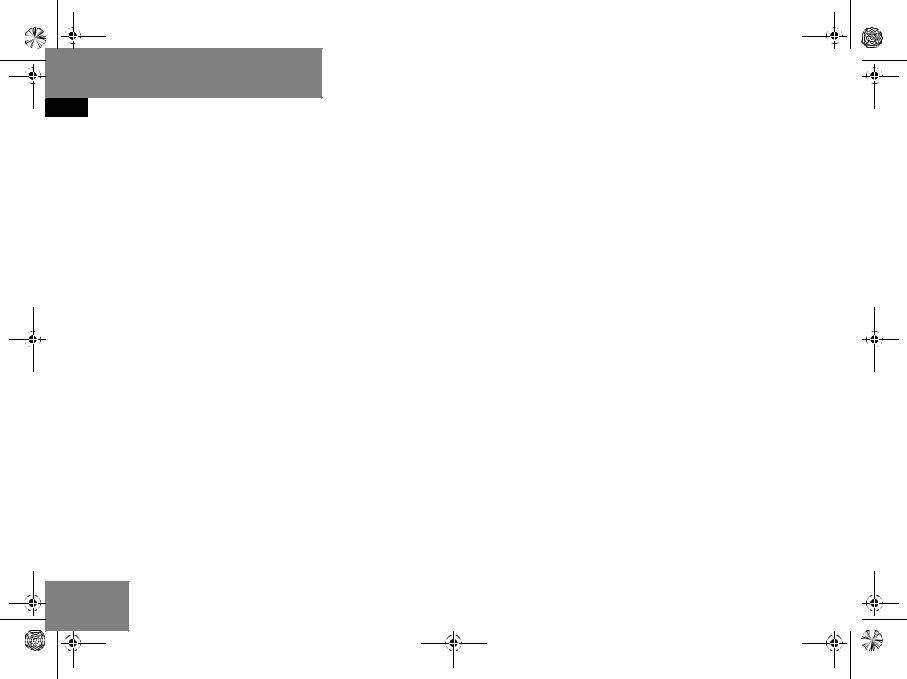
230_Einleitung_US_B.fm Seite 10 Mittwoch, 8. Dezember 2004 3:27 15
Introduction
Operating safety
10
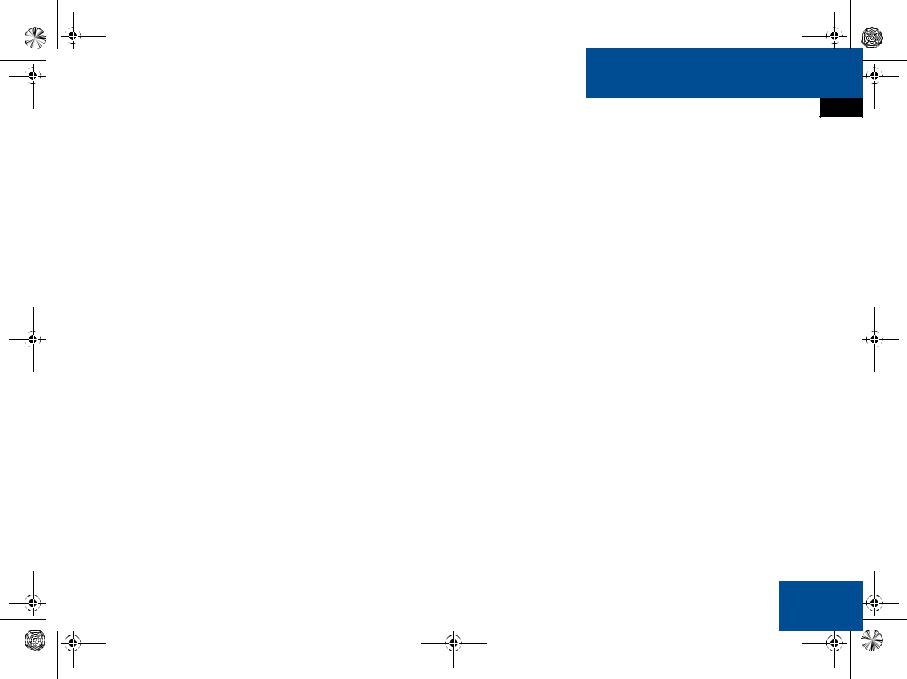
230_AeBlick_US_B.fm Seite 11 Mittwoch, 8. Dezember 2004 3:28 15
At a glance
Radio operating elements CD operating elements Satellite radio* operating elements Telephone* operating elements
Navigation system operating elements Service operating elements Menu system Quick reference COMAND
11
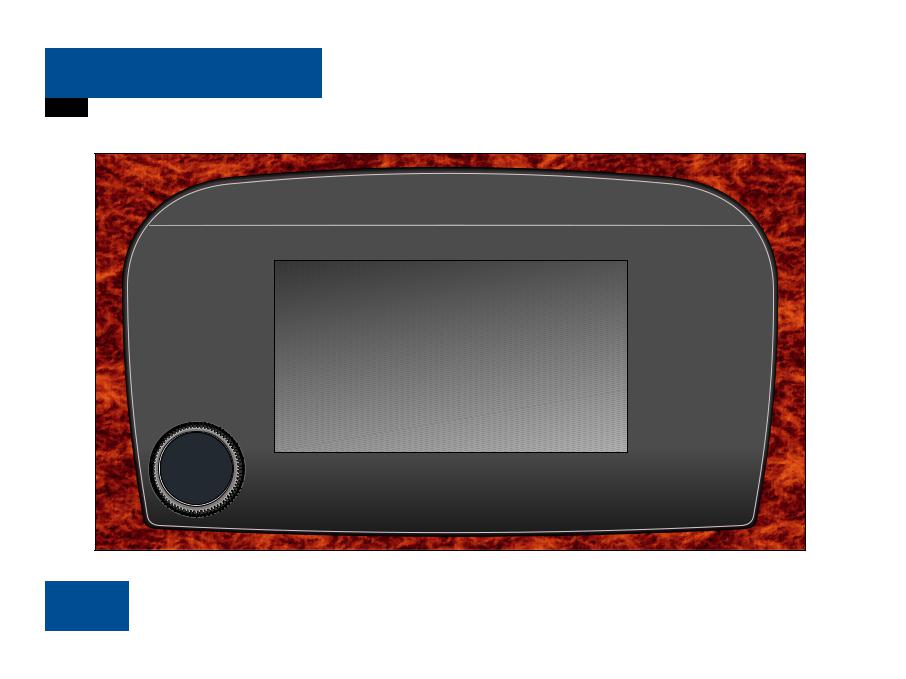
230_AeBlick_US_B.fm Seite 12 Mittwoch, 8. Dezember 2004 3:28 15
At a glance
Radio operating elements
Radio operating elements
12 |
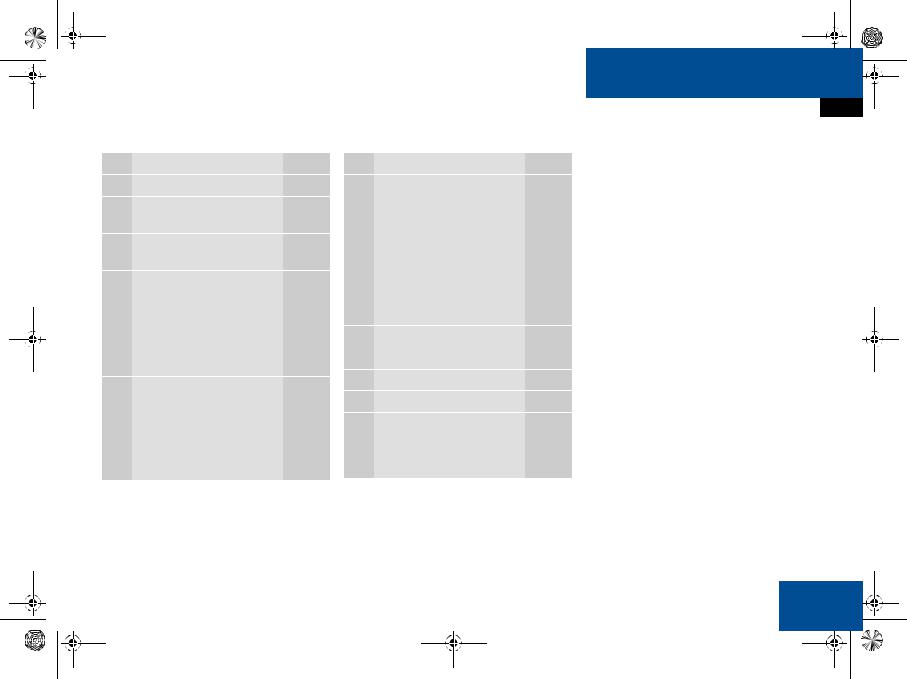
230_AeBlick_US_B.fm Seite 13 Mittwoch, 8. Dezember 2004 3:28 15
At a glance
Radio operating elements
Function |
Page |
1 Audio menu |
34 |
2Soft keys (multifunction keys)
3Color display with Radio main menu
4 |
1 - 0 |
|
|
Station selection |
38 |
|
Saving stations manually |
40 |
|
Selecting a station from |
|
|
the preset memory |
42 |
5 |
E Confirm |
|
Function |
Page |
6H,h,g,G
Function selection g and G
|
e.g. |
|
|
Automatic seek tuning |
37 |
|
H and h |
|
|
e.g. Manual tuning |
37 |
7 |
J |
|
|
Muting |
34 |
8 |
Volume control |
28 |
9 e Switching on and off |
27 |
|
a, |
d and D |
|
b Automatic seek tuning |
37 |
|
|
Manual tuning |
37 |
13
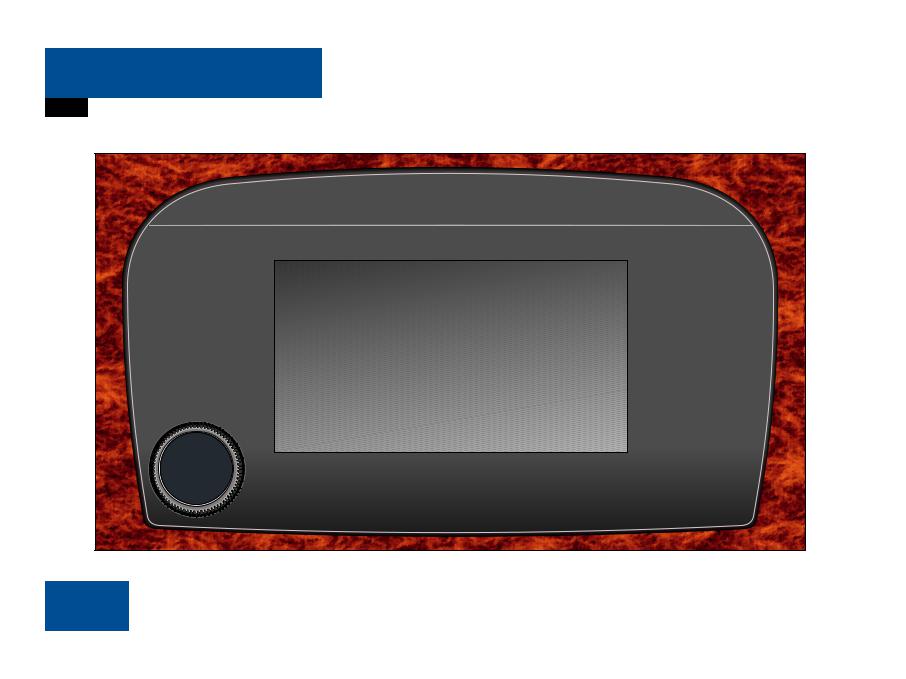
230_AeBlick_US_B.fm Seite 14 Mittwoch, 8. Dezember 2004 3:28 15
At a glance
CD operating elements
CD operating elements
14 |
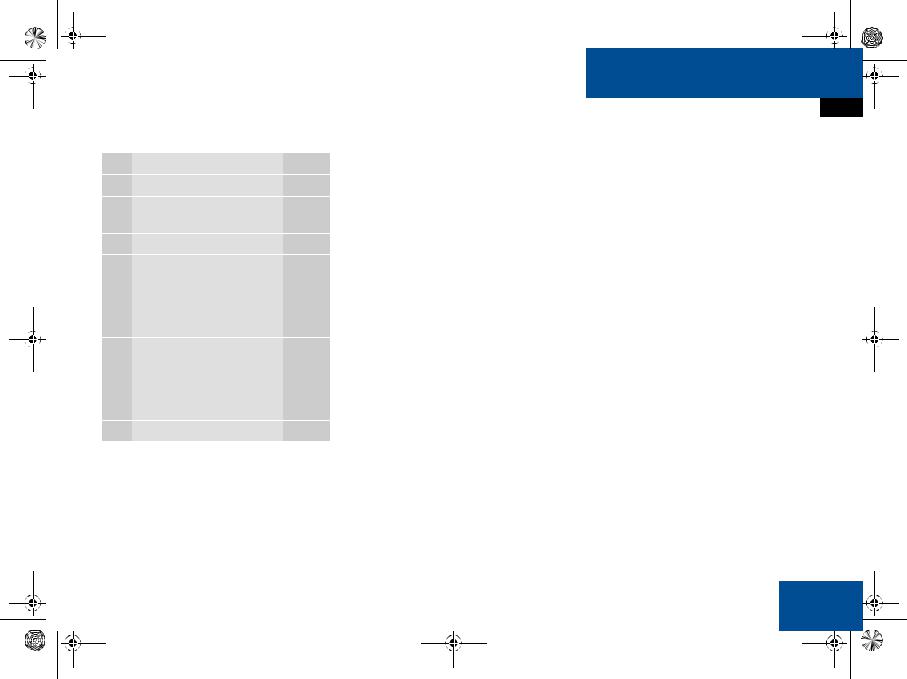
230_AeBlick_US_B.fm Seite 15 Mittwoch, 8. Dezember 2004 3:28 15
Function |
Page |
1 Audio menu |
34 |
2Soft keys (multifunction keys)
3 |
CD changer* main menu |
47 |
4 |
CD/DVD slot |
|
|
i |
|
|
The CD changer* is |
|
|
located in the trunk. |
48 |
5 |
1 - 0 |
|
|
Selecting a CD (CD |
|
|
changer* only) |
49 |
|
Track select |
51 |
6 |
E Confirm |
|
At a glance
CD operating elements
|
Function |
Page |
7 |
H and h |
|
|
Selecting a CD (CD |
|
|
changer* only) |
49 |
|
Selecting a folder |
|
|
(MP3-CD) |
58 |
|
g and G |
|
|
Track select |
51 |
|
Selecting a track |
|
|
(MP3-CD) |
58 |
8 |
CD ejection |
47 |
9 |
J |
|
|
Muting |
53 |
|
|
|
|
Function |
Page |
a |
Volume control |
28 |
b |
e Switch on/off |
27 |
c, |
d and D |
|
d |
Track select |
50 |
|
Fast forward/reverse |
52 |
|
Selecting a track |
|
|
(MP3-CD) |
58 |
|
Skip track (MP3-CD) |
59 |
|
|
|
15
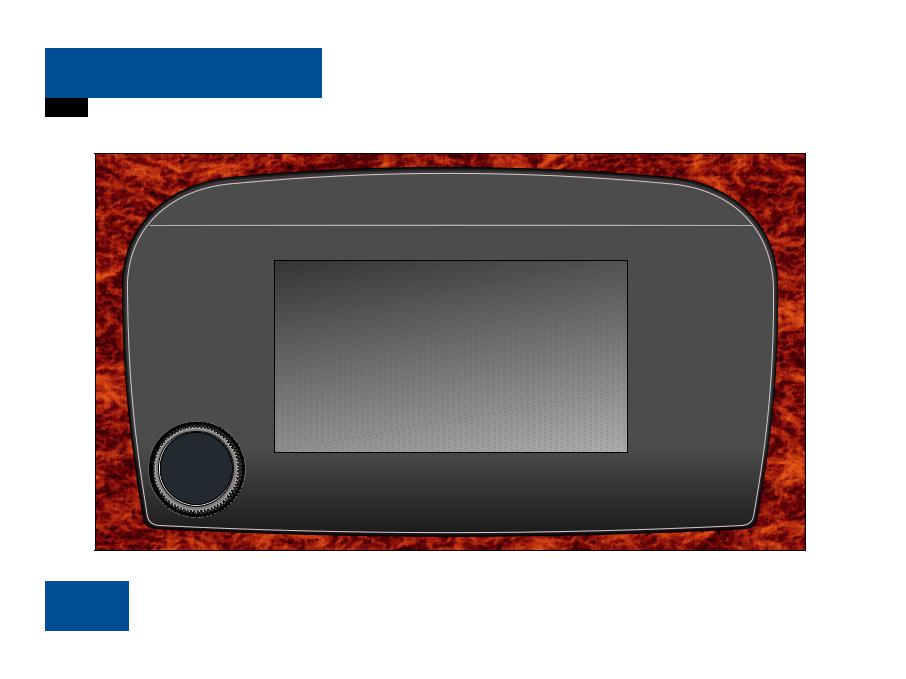
230_AeBlick_US_B.fm Seite 16 Mittwoch, 8. Dezember 2004 3:28 15
At a glance
Satellite radio* operating elements
Satellite radio* operating elements
16 |
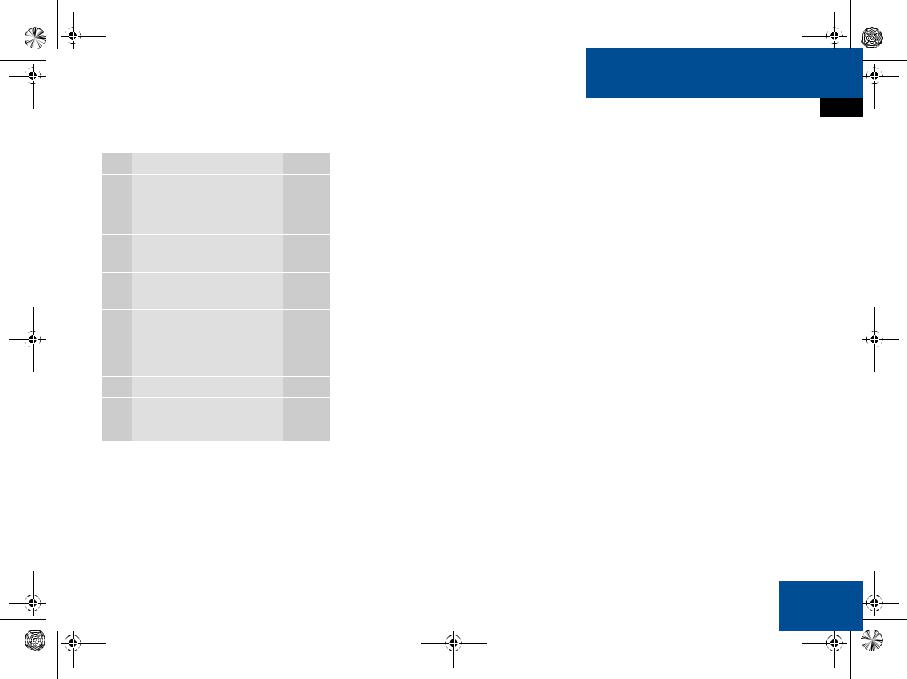
230_AeBlick_US_B.fm Seite 17 Mittwoch, 8. Dezember 2004 3:28 15
At a glance
Satellite radio* operating elements
|
Function |
Page |
1 |
Satellite radio main menu |
80 |
|
Switching satellite radio |
|
|
operation on and off |
80 |
2 |
Soft keys |
|
|
(multifunction keys) |
|
3Color screen with Satellite radio main menu
4 |
1 - 0 |
|
|
Station selection |
82 |
|
Saving stations manually |
83 |
5 |
E Confirm |
|
6 |
H,h,g,G |
|
|
Function selection |
|
|
Function |
Page |
7 |
J |
|
|
Muting |
81 |
8 |
Volume control |
28 |
9 |
e Switching on and off |
27 |
a, |
d and D |
|
b |
Previous or next channel |
81 |
|
|
|
17
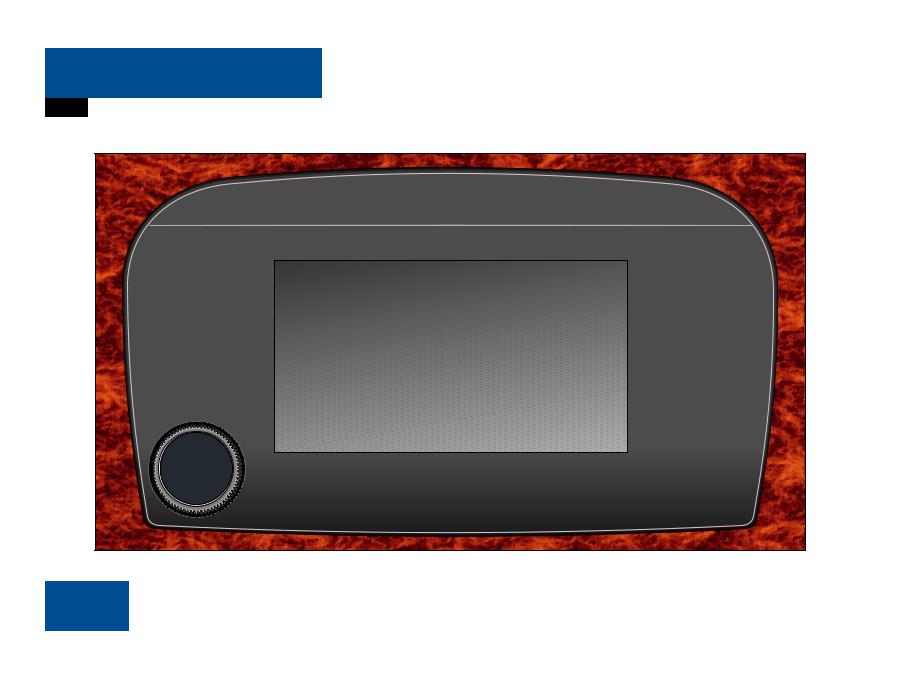
230_AeBlick_US_B.fm Seite 18 Mittwoch, 8. Dezember 2004 3:28 15
At a glance
Telephone* operating elements
Telephone* operating elements
18 |
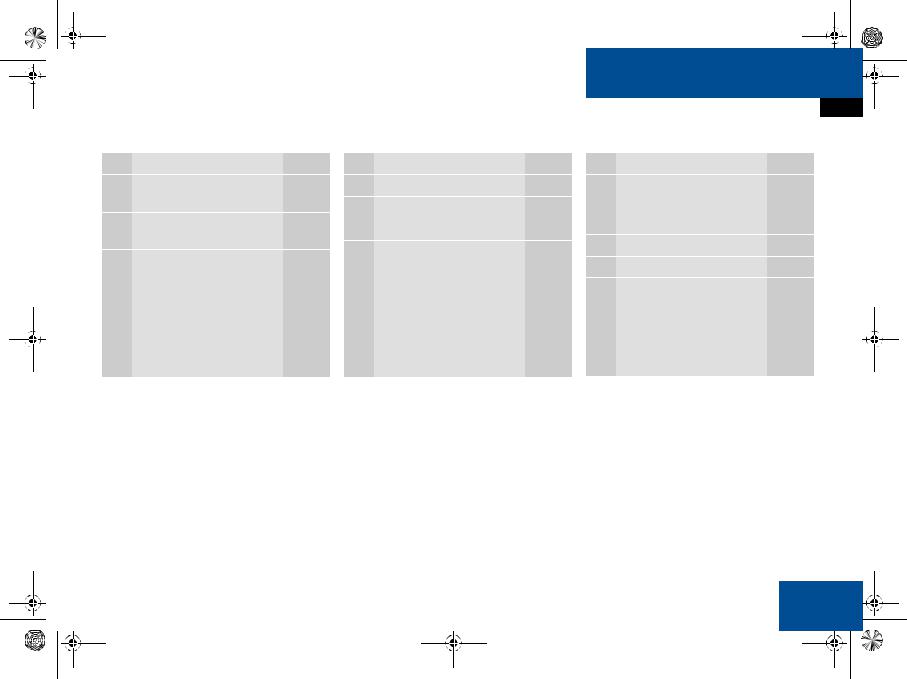
230_AeBlick_US_B.fm Seite 19 Mittwoch, 8. Dezember 2004 3:28 15
Function |
Page |
1Soft keys (multifunction keys)
2 |
Color screen with |
|
|
Telephone menu |
|
3 |
1 - 0 |
|
|
Entering the unlock code |
95 |
|
Entering a telephone |
|
|
number |
98 |
|
Speed-dialing |
102 |
|
Quick-dialing |
102 |
At a glance
Telephone* operating elements
Function |
Page |
4E Confirm
5H,h,g,G,F,f
Function selection
6 k |
|
Accepting a call |
97 |
Making a call |
99 |
Redialing |
99 |
Function |
Page |
7K
|
Muting the ringing tone or |
97, |
|
ending a call |
99 |
8 |
Volume control |
28 |
9 |
e Switching on and off |
27 |
aa
Telephone menu |
96 |
Switching telephone |
|
operation on and off |
92 |
19

230_AeBlick_US_B.fm Seite 20 Mittwoch, 8. Dezember 2004 3:28 15
At a glance
Navigation operating elements
Navigation operating elements
20 |

230_AeBlick_US_B.fm Seite 21 Mittwoch, 8. Dezember 2004 3:28 15
At a glance
Navigation operating elements
Function |
Page |
1Soft keys (multifunction keys)
2Color screen with Navigation main menu
3E Confirm
4H,h,g,G F,f
Function selection
5J
During a voice instruction:
Muting current voice |
|
instruction |
140 |
Switching off voice |
|
instructions |
140 |
Function |
Page |
6j
Repeating current voice
|
instruction |
139 |
|
Switching on voice |
|
|
instructions |
140 |
7 |
Volume control |
28 |
8 |
e Switching on and off |
27 |
9b
Navigation main menu |
118 |
During route guidance: |
|
Change over to navigation |
|
display |
140 |
Cancelling route guidance |
143 |
ac
Switches to map display |
140 |
21

230_AeBlick_US_B.fm Seite 22 Mittwoch, 8. Dezember 2004 3:28 15
At a glance
Service operating elements
Service operating elements
22 |
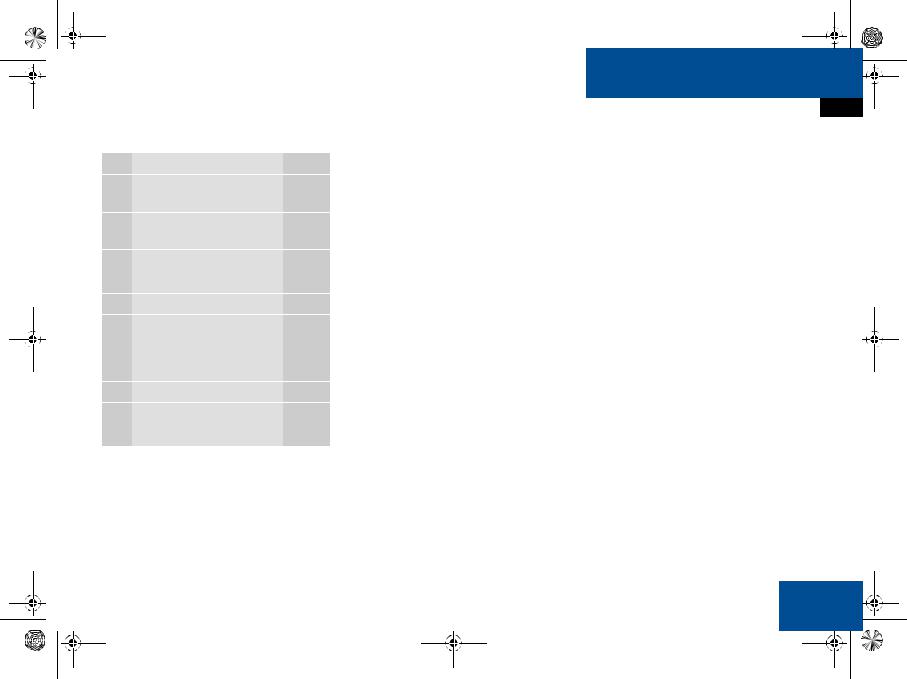
230_AeBlick_US_B.fm Seite 23 Mittwoch, 8. Dezember 2004 3:28 15
At a glance
Service operating elements
Function |
Page |
1Soft keys (multifunction keys)
2Color screen with Service main menu
3 |
1 - 0 |
|
|
Input functions |
|
4 |
E Confirm |
|
5 |
H,h,g,G |
|
|
F,f |
|
|
Function selection |
|
6 e Switching on and off |
27 |
|
7 |
C |
|
|
Service main menu |
168 |
23
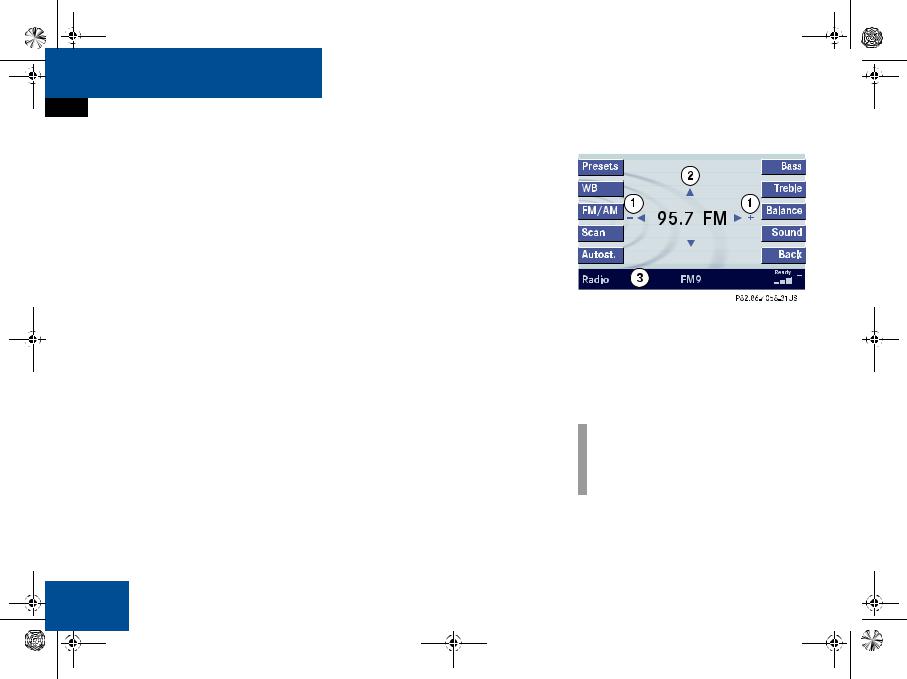
230_AeBlick_US_B.fm Seite 24 Mittwoch, 8. Dezember 2004 3:28 15
At a glance
Menu system
Menu system
The menu system allows for easy operation of COMAND.
Main menus are provided for the following main functions:
Audio
(Radio, CD, CDC*, MP3-CD, DVD)
Satellite radio*
Telephone*
Navigation
Service
Calling up main menus
Audio ( page 34):
Press A.
Satellite radio* ( page 80):
Press B.
Telephone* ( page 96):
Press a. Navigation ( page 118):
Press b.
Service ( page 168):
Press C.
Menu display
A display may consist of three areas. Example: FM menu
24
1 Soft key sections
2 Main area
3 Status bar
The functions currently assigned to the soft keys are displayed in the soft key sections 1.
i
A maximum of five soft keys may be displayed on each side of the main area
2.
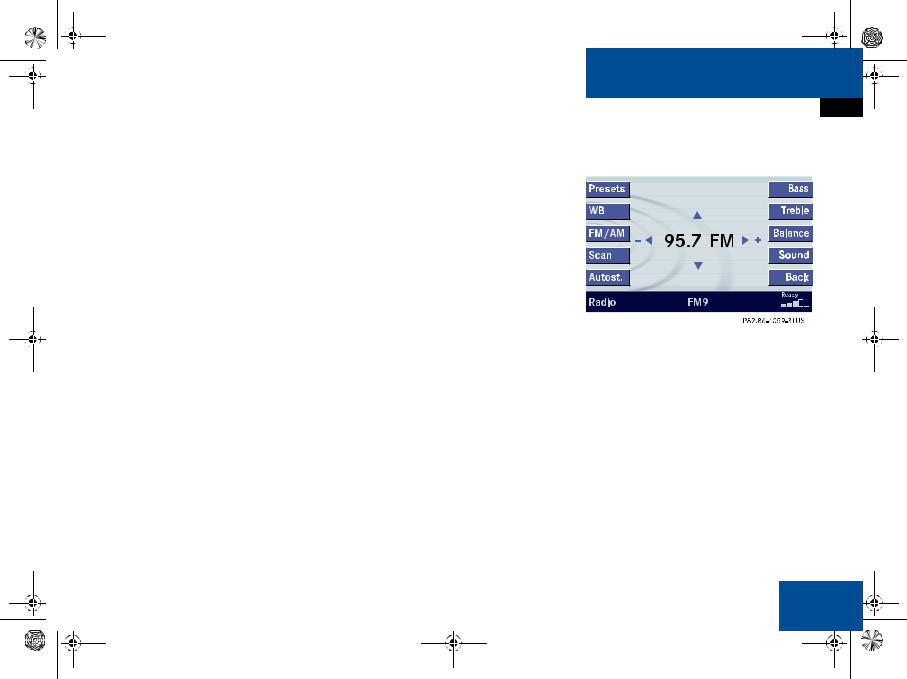
230_AeBlick_US_B.fm Seite 25 Mittwoch, 8. Dezember 2004 3:28 15
The main area 2 shows messages and settings.
You can change the settings by operating the system.
The status bar 3 is divided into three areas.
Left side:
The current operating mode is indicated. In this example: Radio
Center:
The status of the current operating mode or other selectable functions are indicated.
In this example:
FM = current waveband
9 = memory location of station, e.g. “9”
Right side:
General status information is indicated independent of the operating mode.
In this example:
Ready = Telephone* is ready for operation
 = Reception strength of the mobile phone
= Reception strength of the mobile phone
Menu functions and submenus
Using the soft keys, functions can be switched ON or OFF, or submenus can be called up.
At a glance
Menu system
Example: Radio main menu:
The FM/AM soft key switches between FM and AM band.
The Scan soft key starts/stops the channel scan.
In some situations, soft keys may not have any function and are not operational. A soft key without function appears shaded out.
25
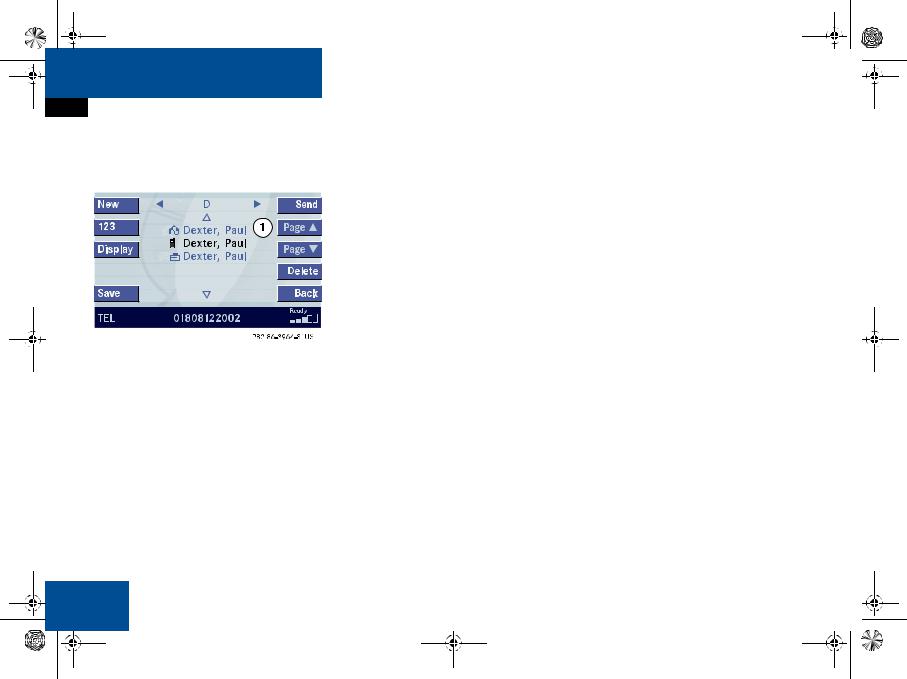
230_AeBlick_US_B.fm Seite 26 Mittwoch, 8. Dezember 2004 3:28 15
At a glance
Menu system
Example Phone book: Page v 1 soft key
26
Exiting from submenus
Use the Back soft key to exit a submenu. The display switches to the next higher menu level.
The system will save all changes you have made. There are exceptions in which pressing the Back soft key will not result in the settings being saved. The exceptions are expressly described on the following pages.
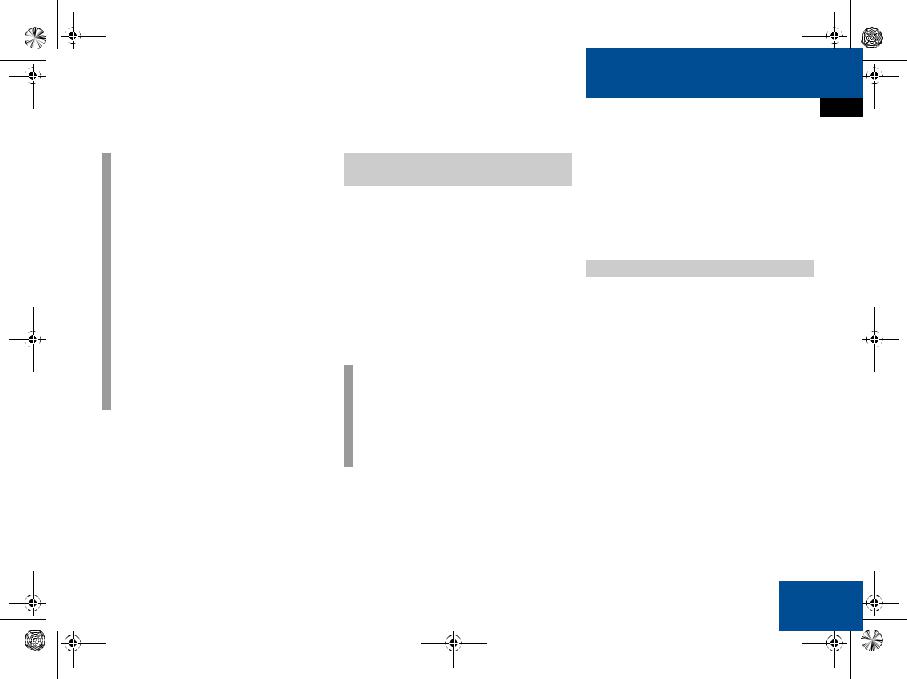
230_AeBlick_US_B.fm Seite 27 Mittwoch, 8. Dezember 2004 3:28 15
Quick reference COMAND
i
You have the following options to control the system:
at the COMAND
at the multifunction steering wheel (refer to vehicle Operator’s Manual)
using the Voice control system* (refer to separate operating instructions for further information)
This Operator’s Manual describes the control at the COMAND.
Unless otherwise indicated, the descriptions and illustrations refer to the COMAND.
Switching the COMAND control unit on and off
Switching on
Turn the key in the steering column lock to position 1 or 2.
or
Press e.
In both cases, the system will activate the operating mode which was active when the system was switched off.
i
If the key is not in the steering lock in position 1 or 2, the system will automatically stop after around 30 minutes. A warning is displayed prior to the system switching off.
At a glance
Quick reference COMAND
Switching off
Turn the key in the steering column lock to position 0 and pull the key out.
or
Press e.
Volume
The volume is adjusted jointly for the telephone*, the navigation system and the Voice control system.
The volume setting applies to other operating modes as well: Radio, CD, CD changer*, MP3-CD and DVD.
When you adjust the volume, the system will automatically store the setting for the current operating mode. The volume for the navigation announcements can only be changed while an announcement is being made.
27

230_AeBlick_US_B.fm Seite 28 Mittwoch, 8. Dezember 2004 3:28 15
At a glance
Quick reference COMAND
Adjusting the volume
At the COMAND, turn the rotary control at the e key.
or
Press J or I on the multifunction steering wheel.
The volume is turned up or down depending on the direction of rotation or the key pressed.
The system remembers the volume setting when it is switched off.
When the system is switched on again, the volume may be lower than at the time when the system was switched OFF.
This will be the case when the volume was adjusted to a value outside a certain range when the system was switched off.
Automatic volume control
The automatic volume control feature adjusts the volume depending on:
vehicle speed (only in vehicles without sound system*)
or
ambient noise inside the vehicle (only in vehicles without sound system*)
other parameters (e.g. windows open or closed)
28
